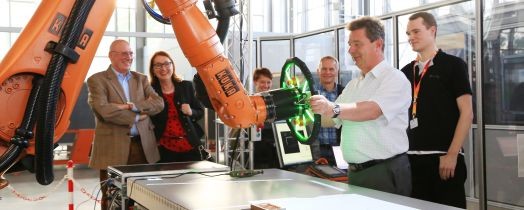Industrial Robots in Collaborative Mode - The STROBAS Project

Posted on Nov 29, 2014 11:06 PM. 3 min read time
The robotic market is now exploding with various ''collaborative robots''. Almost all the main robot manufacturers have their 'collaborative robot' platform. Even if everybody thinks they know what a collaborative robot is... it is often a misnomer. In fact, what most people call collaborative robots are in fact force limited robots.
More and more robotic applications are now done in collaboration with humans, which means that the robot is acting like a collaborative robot, since it works alongside the worker. Although, all kinds of robots can be used to do this, from lightweight robots to gigantic industrial robots. The term 'collaborative' in this context is used to express the fact that the robot works in collaboration with humans while in run mode.

To perform collaborative applications like this, it seems that industry is focusing more on the 'collaborative' aspect of the work being performed with a tendency to abandon traditional industrial robots. But why should you abandon robots that have good specifications in term of speed, accuracy and payload in order to use smaller robots with lower payloads, who are slower and maintain less precision. The point here isn't to disparage the use of collaborative robots, it is to determine how to best understand the differences between force limited robots and collaborative applications.
To understand these differences we need to look at the ANSI/RIA R15.06-2012 safety standard for collaborative robots. There are four modes in which collaborative robots can interact with people.
-
Stand still monitoring: A robot can be powered up and servoing, but stopped (not moving) while the operator works in close proximity of the robot. When the operator is finished and away from the robot, the robot can continue moving at high speeds.
-
Speed and separation monitoring: A robot can be powered up and moving at a reduced speed (250 mm per sec or less) while the operator works within a predefined zone that is not currently shared with the robot. When the operator is finished and away from the robot, the robot can continue moving at high speeds.
-
Hand guiding: A robot can be hand guided by an operator, no high speeds involved here.
-
Power and force limiting: A robot that is limited in the amount of power and force it can exerted (determined by the regulations) can work alongside an operator.
So these are all situations considered as collaborative. The so called collaborative robots are part of the fourth category. Those robots are manufactured to work alongside human. This is why they are all force and power limited. Other types of robots can also work alongside humans using other devices such as vision and different types of sensors. The following example is a good representation of collaborative applications using industrial robots.
STROBAS
The Fraunhofer IFF STROBAS project highlights the next generation of collaborative applications. In the video below you see a large-sized robot being used for a collaborative operation. A lot of the Fraunhofer IFF technologies (projection-based workspace monitoring, tactile sensing, and a novel web-based interface) have been integrated for safety and interaction. The idea is that the robot does some work automatically (lifting the heavy injection mold) and the human can position the part in an ergonomic position to do the spotting (that requires more sensitivity than what a robot can deliver). Another novelty was using the tactile sensing as a three-position enabling switch on the entire surface of the wheel.
So keep in mind that a 'Collaborative robot' can also mean an industrial robot in collaboration mode. You can also expect many innovations in this field in the near future, as projects like STROBAS find new ways to make these powerful, fast and repeatable robots more user friendly and intuitive to interact with.
Related Articles:
Collaborative Robots and Vision System
Teaching Welding Robots by Demonstration








Leave a comment